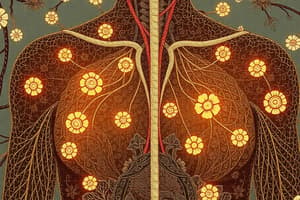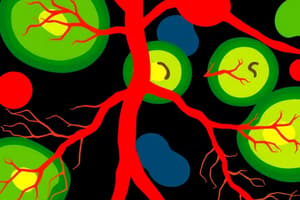Podcast
Questions and Answers
Lymph nodes are large, bean-shaped glands found throughout the body.
Lymph nodes are large, bean-shaped glands found throughout the body.
False (B)
Lymph nodes help filter out bacteria, viruses, and cancer cells from blood.
Lymph nodes help filter out bacteria, viruses, and cancer cells from blood.
False (B)
Lymphatics are vessels located above the skin's surface.
Lymphatics are vessels located above the skin's surface.
False (B)
There is only one type of lymph node with a different name based on its location.
There is only one type of lymph node with a different name based on its location.
Follicles in lymph nodes are areas where B and T lymphocytes mature into red blood cells.
Follicles in lymph nodes are areas where B and T lymphocytes mature into red blood cells.
Macrophages in the cortex of lymph nodes engulf and destroy pathogens.
Macrophages in the cortex of lymph nodes engulf and destroy pathogens.
Flashcards are hidden until you start studying
Study Notes
Lymph nodes are small, bean-shaped glands found throughout your body. They are part of your immune system and help filter out bacteria, viruses, cancer cells, and other harmful particles from your lymphatic fluid. This fluid circulates through vessels called lymphatics, which are located beneath the skin's surface and within internal organs like the lungs and spleen. There are several types of lymph nodes with different names based on their locations, such as cervical, axillary, inguinal, mesenteric, and popliteal. These nodes function together to protect our bodies against diseases.
Lymph nodes contain two main types of components: follicles and cortex. Follicles are areas where immune cells known as B and T lymphocytes mature into antibody-producing plasma cells and memory cells after antigen exposure. On the other hand, the cortex is home to non-lymphoid tissue, which includes macrophages, natural killer cells, dendritic cells, and fibroblasts. Macrophages engulf and destroy pathogens, while natural killer cells attack virus-infected cells without specific recognition. Dendritic cells present foreign organisms to helper T cells, facilitating the activation of immune responses. Fibroblasts produce a protein framework for collagen deposition during wound healing and also release growth factors that regulate the proliferation of various cell types.
When a person becomes infected with a pathogen, such as a bacterium or a virus, it can cause inflammation in the surrounding tissues. As a result, lymphocyte-containing immune cells move toward the site of infection from nearby lymph nodes, where they multiply rapidly and become activated by conditioning factors, ultimately targeting and eliminating the invading microorganism. Once the infection has been resolved, the activated lymphocytes return to the lymph nodes, where they can remain dormant until the next encounter with the same pathogen.
In summary, lymph nodes play a crucial role in protecting us from diseases. They house immune cells that detect, eliminate, and remember pathogens, ensuring our bodies maintain optimal health.
Studying That Suits You
Use AI to generate personalized quizzes and flashcards to suit your learning preferences.




